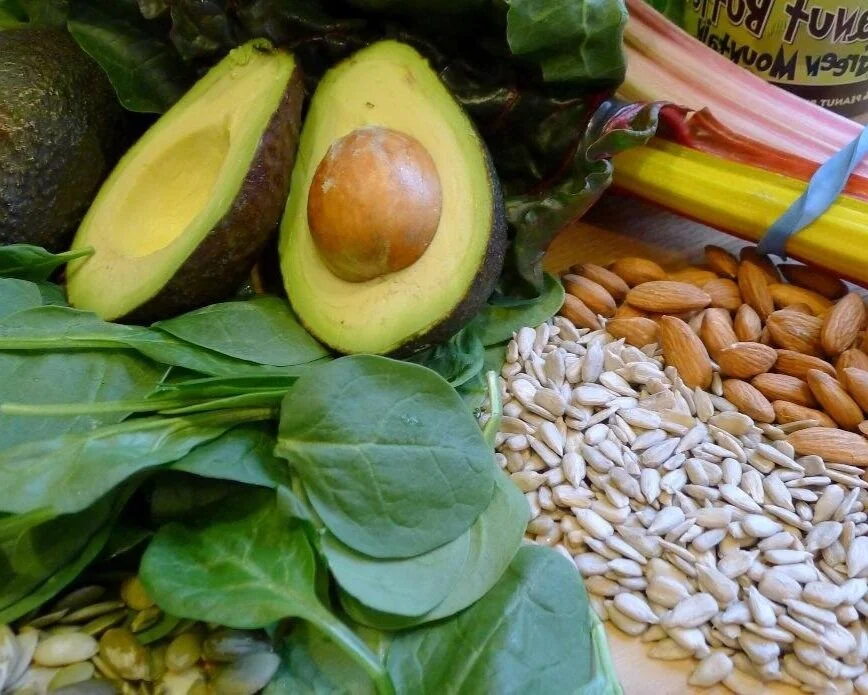10 foods that are high in vitamin E "vitamin of youth"
10 foods that are high in vitamin E
Vitamin E makes us prettier, protects us from viruses and accelerates wound healing. Here are ten foods with the highest amounts of this substance. We advise you to include them in your daily diet.
In 1920, American researchers discovered an unusual fact. The lab rats that were put on a diet of fresh, whole milk stopped producing offspring. A couple of years later, the problem was solved - Herbert Evans and Catherine Scott Bishop added greens to the rodents' diet. This is how α-tocopherol, a type of vitamin E, was discovered. Translated from the Greek word “tocopherol” means “bearing birth”: without this compound, all living organisms would lose their reproductive function.
Vitamin E is a powerful antioxidant. It strengthens hair and nails, improves skin condition and fights early aging. That is why it is often called the "beauty vitamin" and is added to the composition of anti-aging cosmetics.
The beneficial properties of tocopherol are not limited to this. In our body, it serves as a shield: it increases immunity, activates tissue regeneration, prevents blood clots, and enhances the strength and elasticity of blood vessels. In addition, it helps the absorption of vitamins A and D.
Notice! The recommended daily intake of vitamin E for an adult is 15 mg per day. Approximately the same amount is required for pregnant women, and during lactation, the need for tocopherol increases to 17-19 mg per day.
1. Vegetable oil
Vegetable oil is rich in vitamin E. Wheat germ oil is especially rich in it: one tablespoon of the product covers 135% of the daily value of tocopherol. In addition, it lowers cholesterol levels, normalizes metabolism and strengthens the nervous system.
However, such oil is not advised to be consumed by people with cholelithiasis or urolithiasis. Substitute sunflower oil or hazelnut oil - add a spoonful of either to salad or sauce to meet a third of your daily vitamin E needs.
2. Almond
This nut can be eaten either neat or added to various dishes. Or try alternative milk, butter, or almond flour to diversify your diet. 100 g of product contains 26 mg of tocopherol. It is also a valuable source of omega-3s, protein, calcium and fiber. And the fatty acids included in almonds ensure easy and quick absorption of vitamin E.
Notice! Nutritionists advise eating almond kernels along with brown skin. It contains the highest concentration of antioxidants - flavonoids.
3. Pine nuts
Like almonds, cedar is an excellent source of tocopherol. One handful contains 2.7 mg of vitamin E, which covers 18% of the daily need for it. In addition, these nuts are rich in magnesium and phosphorus: these minerals strengthen bones, provide energy, and increase metabolism and performance. And cedar also contains a lot of vitamin A. It is fat-soluble, so it goes well with tocopherol.
And yet, these nuts should not be abused: they are high in calories. It is better to add a little cedar to pasta and porridge.
4. Broccoli
Broccoli is considered one of the best natural detoxifiers. It removes toxins, excess sugar, cholesterol and carcinogens from the body. In addition, broccoli contains a lot of vitamin E: 100 g of vegetable replaces 10% of the daily value of tocopherol. It can be eaten raw, but after a gentle heat treatment, cabbage becomes even healthier.
Notice! To fill the body with vitamins, steam broccoli for no more than 5-10 minutes.
5. Mango
Not all fruits can boast of a high content of vitamin E, but mangoes can. Half of the fruit contains 1.5 mg of tocopherol. This is 10% of the daily value. The juicy and aromatic tropical fruit can be found in almost any supermarket.
Notice! When choosing a mango, be sure to pay attention to the condition of the peel. There should be no damage on it. But you should not press on the fruit: because of this, unripe fruits are injured and begin to rot.
6. Sunflower seeds
Just 43 grams of sunflower seeds make up for the daily deficiency of vitamin E. Although they do not contain bad cholesterol, they are almost 80% fat and have great nutritional value.
Notice! To get the most out of your diet, nutritionists advise taking raw, unpeeled seeds. Without the shell, they are worse stored, and when roasted, they lose vitamins and turn into a source of "empty" calories.
7. Avocado
Supplement your meal with half a medium avocado to offset 14% of your daily value for tocopherol and keep you feeling full for longer. The fruit can be added to a salad, spread on toast, turned into a sauce, and made into a sweet cream. Or, simply cut the avocado in half, remove the pit, drizzle with lemon juice, salt and sprinkle with freshly ground black pepper.
Notice! Even though avocados are rich in fat, research shows that including avocados in your diet can help you consume fewer calories and promote weight loss.
8. Peanut paste
Peanut butter is not just a treat, but also a balanced source of energy. The product consists of 25% easily digestible protein and only 20% carbohydrates. This allows peanut butter to be consumed during periods of low-carb diets. In addition, it is rich in tocopherol: 100 g of the product covers 45% of the daily value of the vitamin.
By the way, making such a paste yourself is not difficult: grind the peanuts in a blender for 10-15 minutes. Add salt, honey, or dark chocolate if desired.
9. Atlantic salmon
Salmon is full of the “vitamin of youth”: a 200-gram steak provides 16% of the daily requirement for tocopherol. And salmon is one of the leaders in the amount of omega-3 and omega-6 fatty acids. Our body cannot synthesize them on its own. With a deficiency of these substances, the hair becomes dull and dry, and the skin becomes thinner.
Notice! Salmon is not suitable for frequent consumption because it accumulates toxic substances from the environment. Doctors advise eating this fish no more than twice a week.
10. Bulgarian pepper
Just one medium bell pepper covers 13% of the daily value of vitamin E. In addition, it contains a daily dose of the rare vitamin P, which strengthens the walls of blood vessels. And in terms of the amount of ascorbic acid, this vegetable surpasses oranges and lemons.
If you add bell pepper to your daily diet, you can restore the intestinal microflora, lower blood pressure, and strengthen the immune system. When choosing a vegetable, carefully look at the skin of the fruit. The less damage and dents it has, the better vitamins are preserved.
Important information about vitamin E
Vitamin E is necessary and important: it participates in many processes in the human body. However, long-term use in high doses can lead to hypervitaminosis. Excess vitamin E is accompanied by headache, dizziness, increased fatigue, abdominal pain, and visual impairment. During pregnancy, vitamin E, like other drugs, is used exclusively on the recommendation of a doctor.
Vitamin E is destroyed by sunlight, so food should be stored in a place where light cannot penetrate. Of all vitamins, tocopherol is the least sensitive to heat treatment. However, it is desirable to shorten the cooking time and use gentle methods of food processing. For example, steam, bake or simmer. The most tocopherol is found in cold-pressed oils, so it is recommended to add them when preparing salads.
In the case of prolonged use of vitamin E, one should remember about the possible effect of the drug on the absorption of other vitamins and microelements. It was found that vitamin E increases the bioavailability and assimilation of vitamins A and C, as well as selenium. At the same time, it reduces the absorption of iron, which is especially important for patients suffering from iron deficiency anemia. In addition, the vitamin should be taken with caution in people who are on anticoagulant therapy (warfarin) and cytostatics (cyclosporine). Tocopherol can interfere with their action.
Due to its properties, vitamin E is widely used in cosmetology. It is found in various cosmetics: serums, oils, creams, emulsions, balms. Tocopherol is an essential component of care products for sensitive and irritated skin, shampoos and hair masks, and medicated nail polishes. It is no coincidence that it is called the "vitamin of youth": tocopherol is used in anti-aging cosmetics lines, as well as in products for the prevention and correction of age-related skin changes.
Vitamin E softens the skin, thereby increasing its elasticity and turgor. It effectively fights pigmentation, which is why it is often included in whitening products. In addition, tocopherol helps to restore the epidermal barrier - it is used for burns, dry skin. Another useful property of this vitamin: it protects the skin from the negative effects of the external environment and is included in various protective creams and lip sticks from frost.













